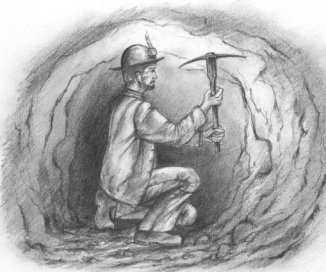|
INTRODUCTION Just
half a mile from the village of Laxey and shadowed by the great
wheel, the mine lies in a steep sided glen astride the River
Mooar in an almost intact condition. The
site, unique due to the ingenious use of the river to supply all the
plant with continuous 'free energy' is perhaps one of the most important
sites of the industrial revolution in Britain. Running for more than
a mile in a north south direction from the washing
floors of lower Laxey to the village of Agneash, the mine was the
workplace of five hundred men. Reaching a depth of more than three hundred fathoms, the mine produced one fifth of the total British output of zinc in the 1870ís along with a massive turnover of lead and a significant supply of copper. HISTORYPerhaps as early as
1770, the first outcrop of ore had been located adjacent to a waterfall,
a short distance up from the wheel, and by 1790 a level had been driven
into the hillside for a distance of 160 yards. This level seems to follow the course of
the river and may have been open cast to extract the ore in some areas.
In 1797 a second adit
(horse level) was started a quarter of a mile down the valley and by
1810 had been driven to a distance of 450
yards. In 1820 it was decided to
sink the first shaft (engine)
from the surface on the now dry river bed connecting the
two levels but in 1836 the river broke in drowning five men. By
1840 the sinking of a second shaft was under way one hundred 1862
saw the introduction of the winding turbine to work both Welsh and
Engine shaft and about the same time, sinking of the Corner shaft in the
southern section of the mine commenced. The ponies were put to grass in 1875 as the length of the new adit increased and two small steam trains named Bee and Ant were put to work. In 1880 the compressor house was built straddling the river and in 1881 construction of the man engine in the Welsh shaft was under way which was finally put to work in March of 1883 after a number of problems. Tragedy struck the mine for the second time in 1901 when a water filled slide was breached on the 255 fathom level flooding the mine to the 110 fathom level. During an inspection following six months of de-watering, a wooden roadway gave way under four men who fell to their deaths in a flooded sump. By this time the mine had reached itís terminal depth of 302 fathoms below adit and worked productively until the abandonment of the man engine in 1919, this was probably a result of the Levant mine disaster in Cornwall. This prompted a strike, which lasted for three years until the mine was taken over by a local businessman Williamson. The mine worked with sixteen men but the Future of the Great Laxey mine was bleak. The pumps were so old and worn that they could not keep the mine dry and the water was rising steadily. By 1929 the water had reached the 140 fathom level and the pumps were finally put to rest. Not quite the end of the story as believed. The lease was renewed and although the men were not mining as such, the 'loose ore' in the upper levels was being collected by a group of miners still working under Mr. Williamson and was brought to the washing floors by one of the little trains, which locals remember seeing at work in 1932. Production dwindled until itís final closure in 1934. In 1929, the water powered machinery at the washing floors was harnessed to work dynamoís and the Laxey Electric Lighting Company was formed.
TODAY Abandoned and lost behind a dense blanket of growth, the surface remains and shafts lay buried beyond the accessible area of the water wheel. In 1965 the wheel was purchased by the Isle of Man Government for £5,000 from the land owner Edwin Kneale. After a major overhaul and the re-instatement of the water supply, the wheel was once again set in motion at a grand re-opening ceremony. It wasnít until 1984 that plans to develop the lost glen as a tourist trail was put forward, then, in 1985 work started on a mass clearance of the undergrowth and the construction of footpaths. In October of 1985, a near disaster occurred when the cafť adjacent to the wheel burnt to the ground. Despite flames leaping through the spokes, Isabella was none the worse for her ordeal and suffered only minor scorching. 1987 brought the first serious reconstruction project when British company Dorothea Restorations re-built the flatrod system linking the wheel to the inverted Tee rocker at the engine shaft. The materials had to be pitch pine as were the originals and suitable size timbers were located in England which were brought to the Island by ferry. The Tee rocker was then restored and balanced by the Laxey Mines Group. Phase 3 was a more ambitious project and no mine site would be complete without an underground experience. The chosen place was the original adit next to the waterfall and the work was carried out by specialist mining engineers TL mining. Although a short trip at present, it is hoped to extend the underground experience in the future. In the following years, the mines group spent considerable time on excavation and stabilisation projects deeper underground and continue to record and document findings which greatly contribute to making attractions like the Laxey Mines possible.
|

 yards up
the glen. This was the
yards up
the glen. This was the